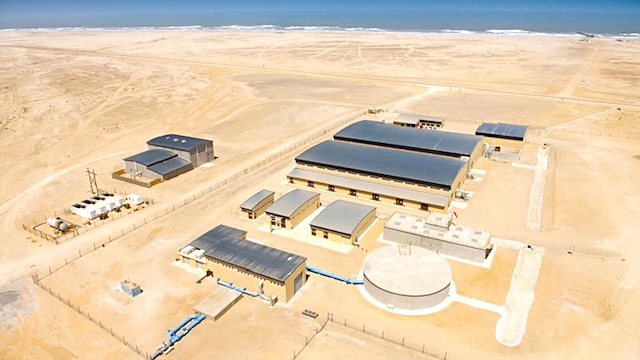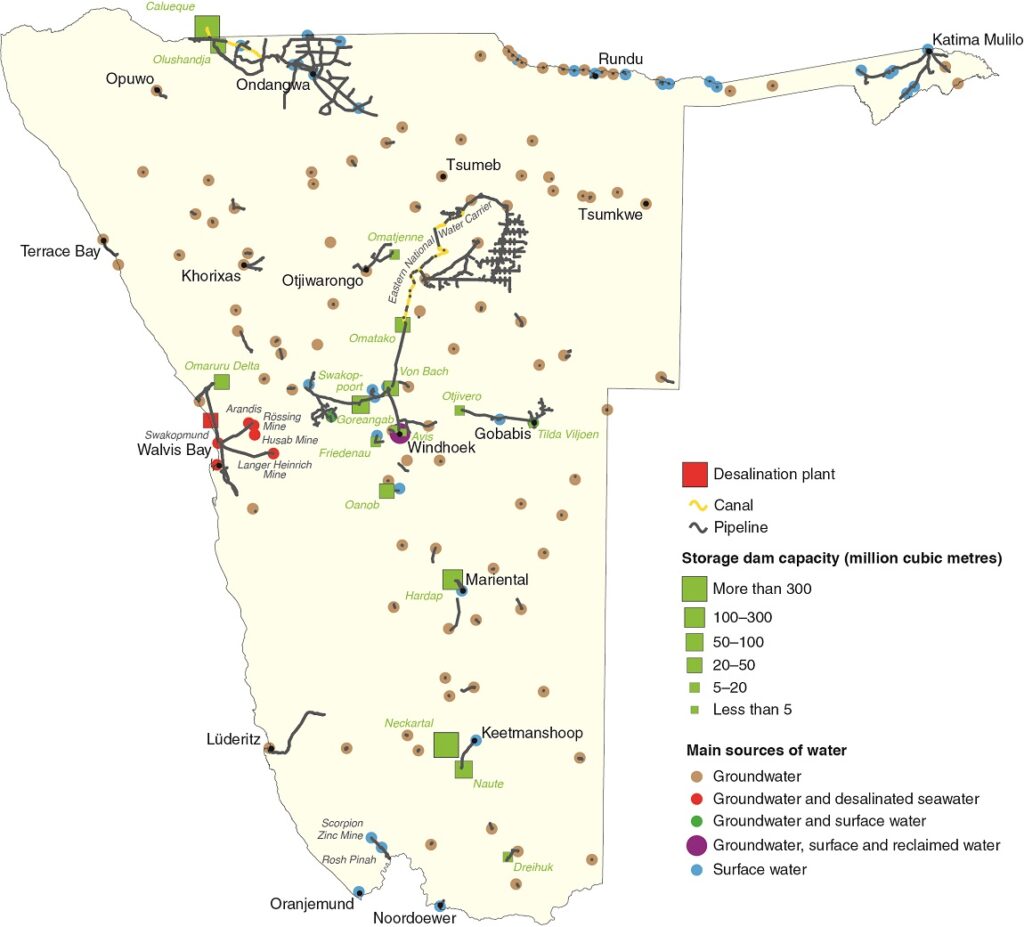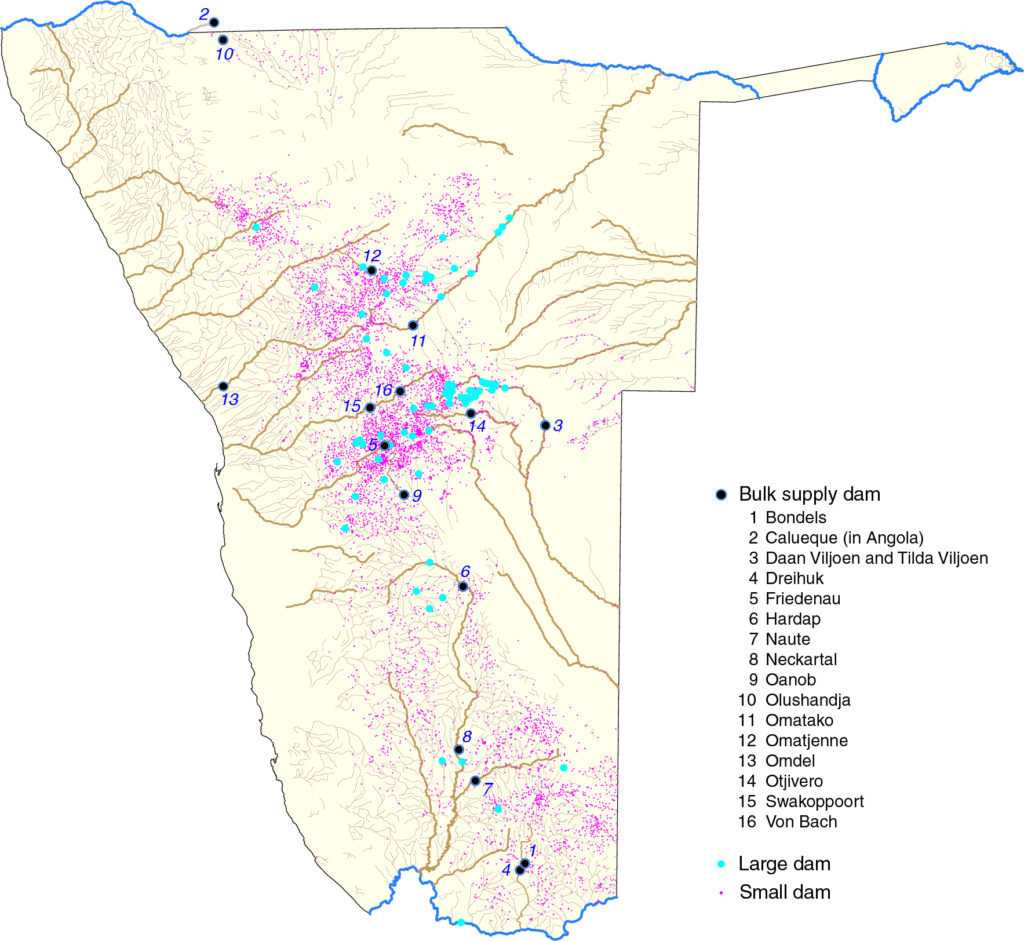The Online Guide to the Namibian Economy
The Online Guide to the
Namibian Economy

Powered by
The Online Guide to the
Namibian Economy
Powered by

Water
Namibia is the most arid country south of the Sahara and a large part of its population is engaged in agriculture. Water is therefore always a challenge and also a highly political issue. This is exacerbated due to the fact that much of the population is concentrated in areas far from where sufficient water is naturally available. Many farmers use their own boreholes as their main source of water supply.

Ministry of Agriculture, Fisheries, Water and Land Reform and Other Public Agencies
The Ministry of Agriculture, Fisheries, Water and Land Reform is the key policy-making institution for the industry headed by the Minister of Agriculture, Fisheries, Water and Land Reform, since May 2025 the Honourable Inge Zaamwani. Water is the responsibility of the Department of Water Affairs which covers both bulk water and rural water supply. There is no explicit water policy covering bulk water which is provided by the Namibia Water Corporation (NamWater), a commercial public enterprise statutorily obliged to cover its costs through the water tariffs it charges. These tariffs have to be approved by Cabinet but the Water Resources Management Act of 2013 makes provision for a separate Water Regulator of Namibia which was formally established in 2017 but is currently dormant. NamWater owns and operates 18 dams, 14 water supply networks and 17 water treatment plants and is responsible for operating the new Neckartal dam in the south near Keetmanshoop, the first major new dam constructed since Independence. A weekly dam bulletin providing information on dam water levels is available from NamWater.
Water Desalination
The Erongo Desalination Company (EDC) plant north of Swakopmund designed and built by Orano and now operated by Nafasi Water is the only desalination plant in the country. The plant, which has intake pipes with the capacity to produce up to 45 million cubic metres of desalinated water annually, was originally built to service Orano’s Trekkopje uranium mine but, since the mine was almost immediately mothballed after construction, it has delivered water to Rössing, Husab and Langer Heinrich mines as well as to the coastal towns of Swakopmund and Walvis Bay supplementing the supply of ground water from the Omaruru Delta and Kuiseb River aquifers. NamWater is once again devoting serious effort into building its own desalination plant alongside the EDC plant. Namibia’s green hydrogen developers are also planning the construction of numerous desalination plants.
[this is needed for pages which display statistics and charts but is not displayed unless you are logged in]
DATA - Sectoral Breakdown of GDP
| Sector | gdp | year |
|---|---|---|
| Livestock Farming | 2.5 | 2024 |
| Crop Farming | 2.1 | 2024 |
| Fishing | 2.7 | 2024 |
| Mining | 13.3 | 2024 |
| Manufacturing | 10.6 | 2024 |
| Electricity and Water | 3.6 | 2024 |
| Construction | 1.4 | 2024 |
| Trade | 11.4 | 2024 |
| Hotels | 1.6 | 2024 |
| Transport and Storage | 3.5 | 2024 |
| ICT | 1.1 | 2024 |
| Financial Intermediation | 7.7 | 2024 |
| Real Estate | 4.7 | 2024 |
| Other Services | 3.0 | 2024 |
| Public Administration | 8.6 | 2024 |
| Education | 9.1 | 2024 |
| Health | 3.3 | 2024 |
| Private Households | 0.7 | 2024 |
| Taxes less subsidies | 9.4 | 2024 |

